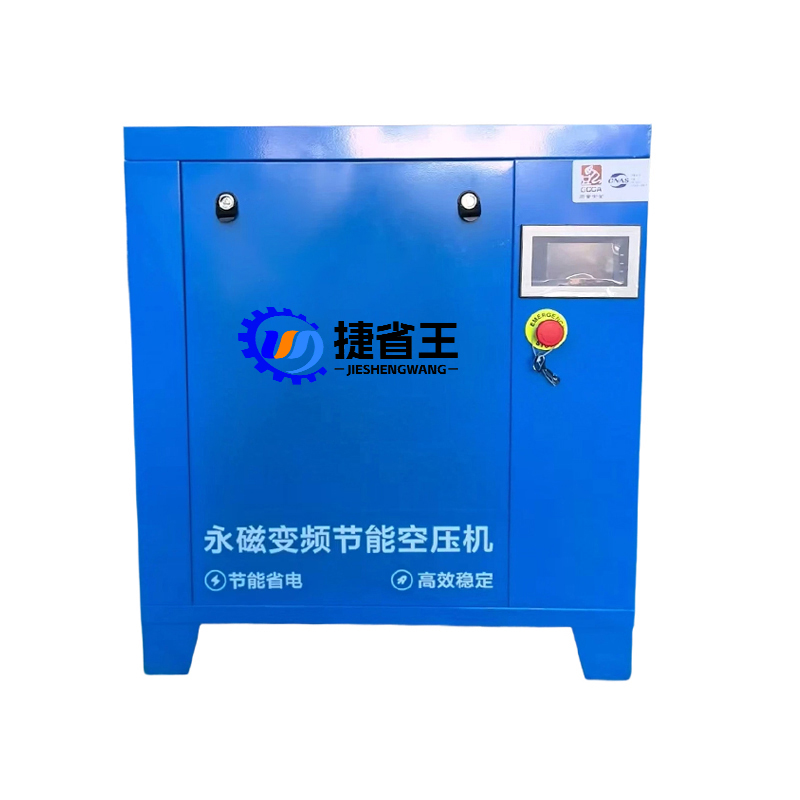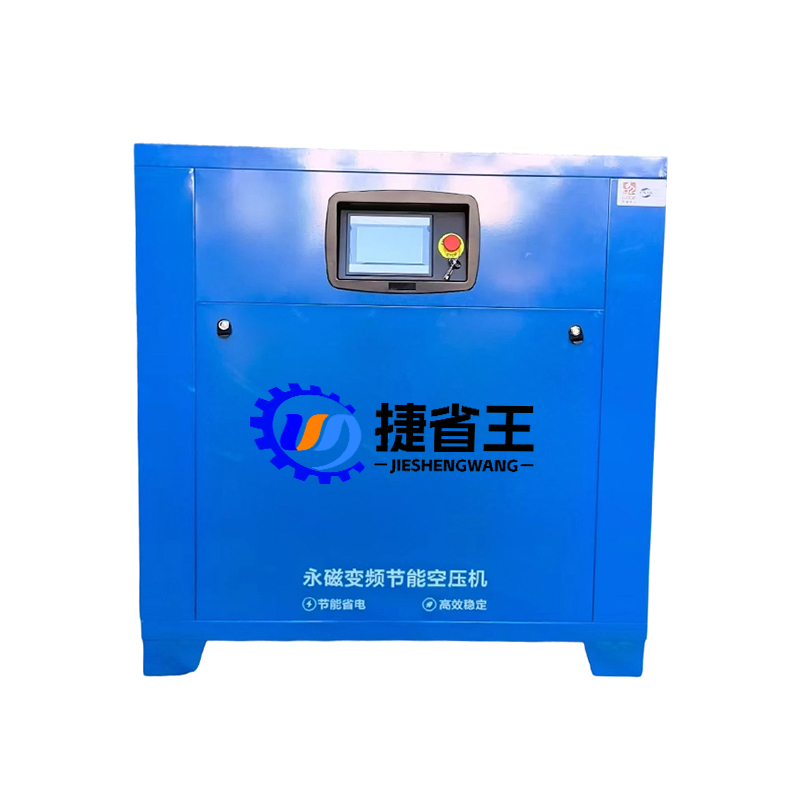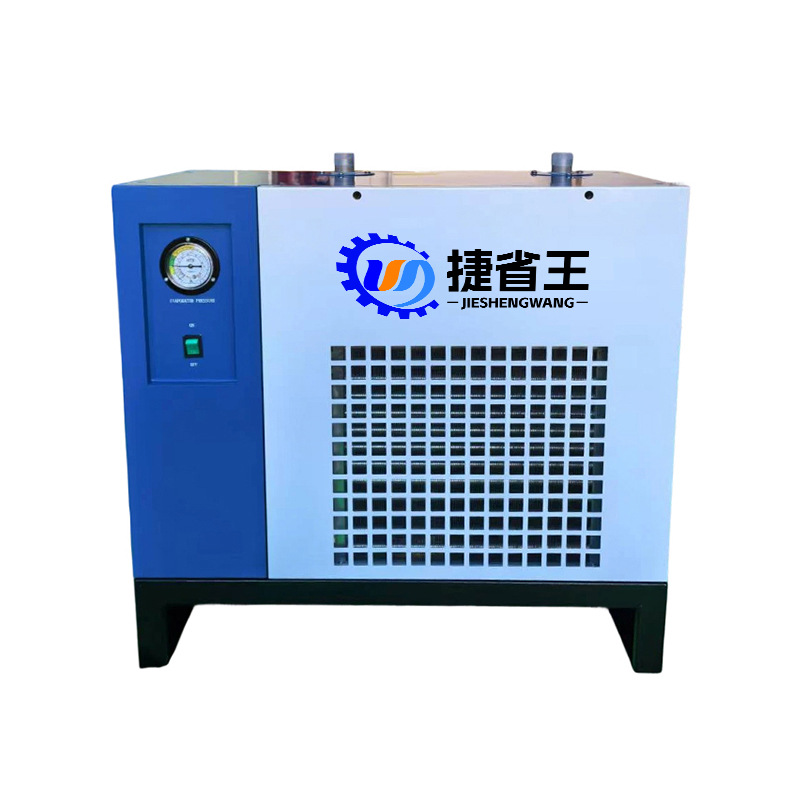How efficient is the permanent magnet variable frequency air compressor under different operating conditions?
Release Time : 2025-11-24
The permanent magnet variable frequency air compressor, with its unique drive technology and intelligent control system, exhibits significant energy-saving advantages under various operating conditions. Its core principle lies in the deep integration of a permanent magnet synchronous motor and variable frequency speed control technology, achieving precise matching between motor speed and actual air consumption. This avoids the energy waste caused by the fixed-speed operation of traditional air compressors. This dynamic adjustment capability allows it to maintain efficient operation under various conditions, with energy savings far exceeding those of traditional fixed-frequency models.
The energy-saving advantages of the permanent magnet variable frequency air compressor are particularly prominent in operating conditions with frequent load fluctuations. For example, in bottling lines in the food and beverage industry, multi-station processing scenarios in electronics manufacturing, and mold switching processes in the injection molding industry, air consumption often fluctuates significantly due to intermittent equipment operation or process changes. Traditional air compressors, unable to adjust speed in real time, continue to operate at full load even when actual air consumption decreases, resulting in a very high proportion of no-load energy consumption. In contrast, the permanent magnet variable frequency model can monitor pipeline pressure in real time through the inverter. When air consumption decreases, the motor speed decreases synchronously, avoiding no-load energy consumption at the source. This "on-demand air supply" mode significantly improves energy efficiency in scenarios with large load fluctuations, even surpassing traditional models in some operating conditions.
For operating conditions with long-term low to medium loads, the energy-saving effect of the permanent magnet variable frequency air compressor is equally significant. Many factories often have actual load rates lower than their design values. If traditional fixed-frequency air compressors are used, the motor will still run at a fixed speed, leading to a "powerful motor for a small load" phenomenon and significant energy waste. However, the permanent magnet variable frequency model, through "speed-torque adaptive" technology, can dynamically adjust the motor speed according to the actual load, ensuring that the equipment always operates within its high-efficiency range. For example, when the load rate drops from 80% to 50%, the motor speed also drops to 50%, and the energy consumption is only 40% of that of a fixed-frequency model. This characteristic allows for high energy savings even under load rates below 70%, resulting in substantial long-term electricity cost savings for businesses.
In operating conditions requiring precise constant pressure, the energy-saving advantages of the permanent magnet variable frequency air compressor are further highlighted. Industries such as spray painting and medical equipment manufacturing have extremely high requirements for air pressure stability, and pressure fluctuations must be controlled within a very small range. Traditional air compressors, due to their cyclical operation mode of "high-pressure unloading - low-pressure loading," not only cause air pressure fluctuations but also waste energy due to frequent start-stop cycles. Permanent magnet variable frequency (PMF) air compressors, through a PID closed-loop control system, can monitor pipeline pressure in real time and automatically adjust motor speed to achieve constant pressure air supply. This mode avoids the cyclical waste of fixed-frequency models, saving additional energy while ensuring the stability of the production process.
Furthermore, the energy-saving effect of the permanent magnet variable frequency air compressor is also reflected in its optimization of grid capacity. Traditional air compressors draw a large current during startup; if the factory's grid capacity is limited, this may cause upstream circuit breakers to trip, requiring additional investment in grid expansion. Permanent magnet PMF air compressors, however, use a soft-start method, resulting in a small starting current and less impact on the grid, saving on grid expansion costs. This characteristic makes them more economical in scenarios with limited grid capacity.
From an equipment maintenance perspective, the energy-saving advantages of the permanent magnet variable frequency air compressor are indirectly reflected in reduced maintenance costs. Its soft-start method reduces electrical shock to the motor's electrical components, extending contactor life; simultaneously, it reduces mechanical shock to the equipment, decreasing wear on motor bearings, main bearings, and gearboxes, further extending equipment lifespan. Furthermore, the high-efficiency energy-saving controller keeps the equipment under load most of the time, reducing the number of operations of solenoid valves and pneumatic components, lowering the failure rate, and further saving on maintenance and labor costs.
In operating conditions with large load fluctuations, low to medium load operation, precise constant pressure requirements, and limited grid capacity, the permanent magnet variable frequency air compressor can significantly reduce energy consumption by dynamically adjusting the motor speed to achieve on-demand air supply. Its energy-saving effect stems not only from the advanced technology itself but also from its deep adaptation to actual operating conditions. For enterprises seeking cost reduction and efficiency improvement, choosing a permanent magnet variable frequency air compressor is undoubtedly an important way to optimize energy utilization and enhance production stability.






